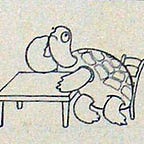191. Today in 1920s Turkey: 29 June 1927 (Istanbul Welcomes Mustafa Kemal Pasha)
This illustration graces the entire front page of today’s issue of Karagöz, indicating the significance of its message. The summer of 1927 was marked with a very special, and long-awaited event: the arrival of the country’s first president and leader of the War of Independence, Mustafa Kemal (Atatürk). As such, this imagery betrays a profound sense of anticipation for the fast-approaching reunion.
The man in question is not yet represented here, as we wait in suspense for his arrival. Indeed, this issue of the bi-weekly magazine, which was published on Wednesdays and Saturdays, hit the newsstands two days prior to the President’s return, scheduled for Friday. This anticipation is heightened with additional content — a column on page 2, and a poem on page 3 — on the subject of the upcoming presidential visit.
The cover illustration features two men, Karagöz and Hacivat who are the magazine’s mascots and namesake. Smaller renditions of the two characters, borrowed from the popular Turkish shadow puppetry tradition, flank the journal’s name above in its masthead. These characters are often included in many of the publication’s cartoons and illustrations. Here, they stand at a set of columns on either side of the picture’s frame. The columns are connected above with leafy grape vines, like a victory arch, under which the proverbial “red carpet” has been laid. The carpet extends out to the edge of a maritime port, most likely the Dolmabahçe dock outside of the newer but defunct Ottoman Palace grounds, where the presidential carrier is expected to land. A large boat out in the sea represents this method of transportation.
The illustration’s clever use of space keeps the center of the composition empty and barren with only a few listless waves in the sea… the anticipated visitor is not yet here, and his absence is emphasized with this emptiness, which will soon be filled. This excitement for his arrival is warranted as the nascent state’s founding father had not stepped foot in Istanbul, the former Ottoman capital, since he left for Anatolia to start the War of Independence in 1919. And although the war was won back in the summer of 1922, Mustafa Kemal Pasha had not returned to the country’s largest and most prominent metropolis in all of the first four years of his presidency, even though he spent much of those years traveling around the rest of the country. Thus, this visit was not only necessary, but long overdue.
There is text below the illustration, which has been partially cut off. It reads “Istanbul is waiting [?] to be reunited with the Great Gazi (İstanbul Büyük Gazi’ye kavuşmak için bütün … bekliyor).” Text also exists in the signage attached to the decorative arrangement aimed at the visitor. The sign, which is fully vocalized, not unlike a fine calligraphic panel, reads “Thank you my Gazi Pasha” (Sağol Ey Gazi Paşam). This expression of gratitude is one that the city of Istanbul — freed from 5 long years of Allied occupation in 1923 after the successful conclusion of the War of Independence — will be able to convey to “Gazi” Mustafa Kemal Pasha in person for the first time. (Note: Gazi is a military title, meaning “veteran/hero.” Mustafa Kemal was often referred to by this title alone in the latter half of the ‘20s.)
